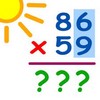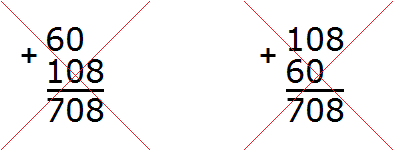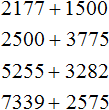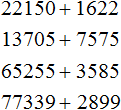Long addition
 Definition. Long addition is a math operation for adding numbers together. Adding in columns is done by digits - ones are added to ones, tens to tens, hundreds to hundreds, thousands to thousands.
Definition. Long addition is a math operation for adding numbers together. Adding in columns is done by digits - ones are added to ones, tens to tens, hundreds to hundreds, thousands to thousands.
Let us have a few examples.
Example 1. Add 61 and 23.
Write first the first number and then the second number, so that the ones and tens of the second number are under the ones and tens of the first number. Write all this with the addition sign (+) vertically:

Now add the units of the first number to the units of the second number, and add the tens of the first number to the tens of the second number:

We got 61 + 23 = 84.
Example 2. Add 108 and 60
Write down the numbers in columns. Units under ones, tens under tens:

Now add the units of the first number to the units of the second number, the tens of the first number to the tens of the second number, the hundreds of the first number to the hundreds of the second number. But only the first number 108 has hundreds. In this case the number 1 of hundreds is added to the new number (our answer). As they used to say in school, it is "carried off:

You can see that we blew off the number 1 to our answer.
When it comes to addition, it makes no difference in what order to write the numbers. Our example could have been written that way:

The first entry, where the number 108 was at the top, is more convenient to calculate. A person is free to choose any entry, but it must be remembered that ones must be written strictly under ones, tens under tens, hundreds under hundreds. In other words, the following entries will be wrong:

If suddenly when adding the corresponding digits you get a number which does not fit in the digit of the new number, you must write one digit from the lowest digit and carry the remaining digit to the next digit.
In this case, we are talking about a digit overflow, which we talked about earlier. For example, if you add 26 and 98, you get 124. Let's see how this works.
Let's write the numbers in columns. Units under ones, tens under tens:

Add the units of the first number to the units of the second number: 6+8=14. We get the number 14, which does not fit in the units digit of our answer. In such cases, we first remove the digit in the units digit of 14 and write it in the units digit of our answer. The digit 4 is in the units digit of 14. Write this digit in the units digit of our answer:

What do we do with the number 1 of 14? Here begins the most interesting part. We move this one to the next digit. It will be added to the tens digit of our answer.
We add tens to tens. 2 plus 9 equals 11, plus we add the one we got from number 14. Adding our unit to 11 gives us the number 12, which we write in the tens digit of our answer. Since this is the end of the solution, it is no longer a question of whether the answer will fit in the place of tens. We write down 12 in its entirety, forming the final answer.

The answer is 124.
Speaking by the traditional method of addition, adding 6 and 8 units results in 14 units. 14 units is four ones and one tens. We wrote four units in the category of units, and one tens was sent to the next category (to the category of tens). Then we added 2 tens and 9 tens to get 11 tens, plus we added 1 tens which was left when we added units. The result was 12 tens. We wrote down these twelve tens in their entirety, forming the final answer 124.
This simple example demonstrates the school situation in which they say "four in writing, one in mind. If you are going to solve examples and you have a digit left over after adding the digits, write it above the digit where it will be added. That way you won't forget it:

Example 2. Add up the numbers 784 and 548.
Write the numbers in columns. Units under ones, tens under tens, hundreds under hundreds:

Add the units of the first number to the units of the second number: 4+8=12. 12 does not fit into the order of units of our answer, so we remove digit 2 from the order of units from 12 and write it in the order of units of our answer. And we carry digit 1 to the next digit:

Now add the tens. Add 8 and 4 plus the one left over from the previous operation (the one left over from 12, it is highlighted in blue in the picture). We add 8+4+1=13. The number 13 will not fit in the digit of tens of our answer, so we will write the number 3 in the digit of tens, and the unit will be moved to the next digit:

Now we add hundreds. Add 7 and 5 plus the one left over from the previous operation: 7+5+1=13. Write the number 13 in the row of hundreds:















2. If you find an error or inaccuracy, please describe it.
3. Positive feedback is welcome.